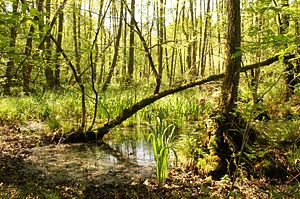Fleuthkuhlen
|
Fleuthkuhlen nature reserve
|
||
|
Swampy swamp forest area in the Fleuthkuhlen NSG near the Beerenbrouck house in Geldern (2016) |
||
| location | Geldern and Issum , Kleve district , North Rhine-Westphalia , Germany | |
| surface | 5.88 km² | |
| Identifier | KLE-005 | |
| WDPA ID | 163117 | |
| Natura 2000 ID | (partly) DE-4404-301 (partly) | |
| Geographical location | 51 ° 32 ' N , 6 ° 22' E | |
|
|
||
| Setup date | 1981 | |
| Framework plan | Landscape plan Geldern / Issum | |
| administration | Lower landscape authority of the Kleve district | |
The Fleuthkuhlen are a nature reserve on the Lower Rhine in North Rhine-Westphalia , which lies between Geldern and Issum and covers an area of around 588 hectares .
With the exception of a few peripheral areas, almost the entire nature reserve is also designated as FFH area DE-4404-301 Fleuthkuhlen , which means that these areas belong to the European Natura 2000 network of protected areas . However, the FFH area extends to Kevelaer over parts of the Issumer Fleuth nature reserve .
The Fleuthkuhlen are a low moor complex in the lowlands of the Issumer Fleuth , consisting of 53 shallow still waters. These waters were created in the 18th and 19th centuries by peat mining . After the up to three meters thick layers of peat had been removed, the holes quickly filled with groundwater and rainwater. These small ponds are popularly called Kuhlen or Kullen.
The Fleuthkuhlen are significant for nature conservation mainly due to the types of swamp, reed and water vegetation. The cutting edge , a sour grass that is very endangered, forms even larger stands here. Other endangered species are the water feather , the tongue buttercup , the hemlock , the serpentine , the marsh ragwort , the marsh fern and the tubular horse seed . The white water lily , the frog bite and the alpine pondweed are the particularly endangered species of aquatic vegetation.
One of the rarest breeding bird species in North Rhine-Westphalia, the water rail, lives in the nature reserve . Also on the red list are the black woodpecker , the oriole , the lapwing , the little grebe , the reed warbler and the kingfisher . Among the fish are the mud whip and the bitterling . Among the amphibians the moor frog and among the reptiles grass snake and forest lizard are to be mentioned.
An area of 147 hectares was bought by the North Rhine-Westphalia Foundation in order to secure it permanently for nature conservation. The area has been looked after by the Gelderland Nature Conservation Center in the NABU- Kreisverband Kleve since 1995 .
See also
Web links
- Nature reserve "KLE-005 Fleuthkuhlen" in the specialist information system of the State Office for Nature, Environment and Consumer Protection in North Rhine-Westphalia
- The Fleuthkuhlen (PDF) - Brochure from the NRW Foundation and NABU with a route map
- Fleuthkuhlen - Information page of the NABU district association Kleve on the area
Individual evidence
- ↑ a b nature reserve "KLE-005 Fleuthkuhlen" in the specialist information system of the State Office for Nature, Environment and Consumer Protection in North Rhine-Westphalia
- ↑ Natura 2000 area DE-4404-301 in the specialist information system of the State Office for Nature, Environment and Consumer Protection in North Rhine-Westphalia
- ↑ a b c Fleuthkuhlen: Description of the area. In: www.nrw-stiftung.de. NRW Foundation , accessed on October 13, 2016 (information on the NSG and the foundation's own areas).
- ↑ Documentation on the 10th anniversary of the Gelderland Nature Conservation Center 1993–2003. In: www.nabu-kleve.de. Retrieved on October 13, 2016 (information and photos on several subpages).

